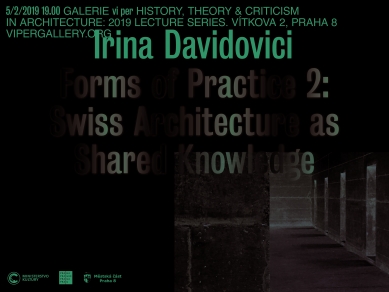
Irina Davidovici: Forms of Practice 2: Swiss Architecture as Shared Knowledge
Forms of Practice 2: Swiss Architecture as Shared Knowledge Irina Davidovici will be addressing architecture in the German-speaking part of Switzerland during the 1980s and 1990s, known worldwide for its formal austerity, construction rigor, and material tactile quality. In the first edition of her book Forms of Practice: German-Swiss Architecture 1980–2000 (2012), Davidovici distanced herself from this foregrounded definition of architecture based on its appearance. She contrasted this with her description of architecture, which is constantly redefined by the differing and evolving briefs of individual architects and studios, including names such as Diener & Diener, Herzog & de Meuron, Valerio Olgiati, and Peter Zumthor. Their buildings are founded on an ethical basis, respecting the distinctive character of local culture, differing among cantons and cities. Their various “forms of practice” from the book's title are furthermore conditioned and linked by a shared cultural, theoretical, and professional background that represents deeper common aspects of Swiss architecture. Davidovici engages in a series of reflections that led to the second, revised, and expanded edition of her book (2018), introducing inherited design approaches as well as new challenges faced by younger representatives of Swiss architectural practice. In her introduction, Davidovici focuses on the search for “forms of practice” from the 1980s and 1990s in the context of emerging “communities of practice” that now operate across Europe. She proposes that we reevaluate Swiss architecture and perceive it as a shared set of professional knowledge and overarching design methodology functioning across generations of professionals and cultural boundaries.
Irina Davidovici is an architect and researcher in the Department of History and Theory of Urban Planning at ETH Zurich. Her areas of expertise include theory and criticism of contemporary architecture, methodologies of professional education and design in Switzerland and the UK, as well as the history and ideologies of European urban housing. Davidovici has held fellowship positions such as Harvard GSD Richard Rogers Fellow (2018), gta Postdoctoral Fellow (2016–2017), and SNF Marie Heim-Vögtlin Fellow (2014–2016) at ETH Zurich. Previously, she taught the history and theory of architecture at Kingston University (2008–2013). In 2008, she obtained her PhD in the history and philosophy of architecture from the University of Cambridge and the following year received the RIBA President's Research Award for her outstanding dissertation. She participated in the collaborative research project Flora Ruchat-Roncati at ETH Zurich 1985–2002; she is currently completing her habilitation thesis Collective Grounds: Housing Estates and the European City, 1865–1940. In addition to her book Forms of Practice: German-Swiss Architecture 1980–2000 (2012, second expanded edition 2018), she has published articles in journals such as AA Files, ARCH+, Casabella, OASE, Joehlo, and Project Journal, and edited the publication Colquhounery: Alan Colquhoun from Bricolage to Myth (AA Publications, 2015).
Irina Davidovici is an architect and researcher in the Department of History and Theory of Urban Planning at ETH Zurich. Her areas of expertise include theory and criticism of contemporary architecture, methodologies of professional education and design in Switzerland and the UK, as well as the history and ideologies of European urban housing. Davidovici has held fellowship positions such as Harvard GSD Richard Rogers Fellow (2018), gta Postdoctoral Fellow (2016–2017), and SNF Marie Heim-Vögtlin Fellow (2014–2016) at ETH Zurich. Previously, she taught the history and theory of architecture at Kingston University (2008–2013). In 2008, she obtained her PhD in the history and philosophy of architecture from the University of Cambridge and the following year received the RIBA President's Research Award for her outstanding dissertation. She participated in the collaborative research project Flora Ruchat-Roncati at ETH Zurich 1985–2002; she is currently completing her habilitation thesis Collective Grounds: Housing Estates and the European City, 1865–1940. In addition to her book Forms of Practice: German-Swiss Architecture 1980–2000 (2012, second expanded edition 2018), she has published articles in journals such as AA Files, ARCH+, Casabella, OASE, Joehlo, and Project Journal, and edited the publication Colquhounery: Alan Colquhoun from Bricolage to Myth (AA Publications, 2015).
The English translation is powered by AI tool. Switch to Czech to view the original text source.

0 comments
add comment









